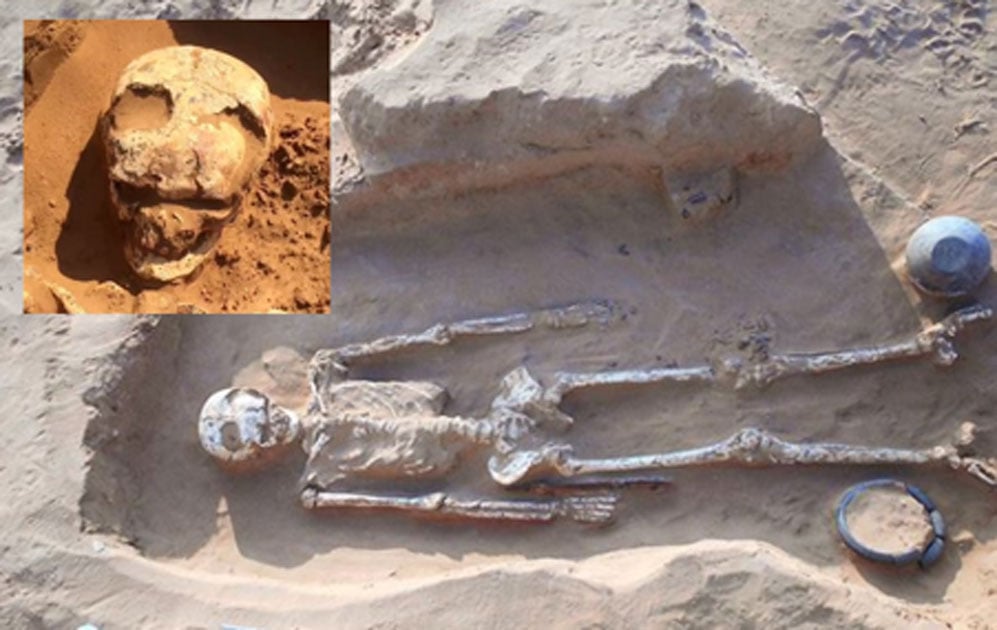Remains Show Brain Surgery Not Battle Killed This Sarmatian Warrior 1,800 Years Ago
Archaeologists in Russia have found the grave of a warrior who did not die directly of his battle wounds but as a result of a failed surgical procedure performed on his skull. Near him was found a toddler buried with a hoard of jewelry, thought to be a member of the tribe’s ‘elite’. The obscure find has opened a trail of intrigue as to the connection between the two and their role in the culture. Experts expect further study of this distinctive find will provide new insights into the nomadic culture that roamed the Eurasian Steppes 2,000-years-ago.
A distinctly Sarmatian burial
The graves were found by Russian archaeologists who have been excavating a site in the Astrakhan area in Russia, which is close to the Caspian Sea. The Sun reports that the archaeological site “was discovered earlier this year by a local farmer who found a bronze pot while making a garbage pit on his land”. This had a treasure trove of gold and silver artifacts. The Astrakhan site is associated with the Sarmatians, a nomadic people who dominated the Eurasian Steppes between 1800 and 2000 years ago. These nomads regularly raided the Roman Empire and were renowned for their heavy cavalry.
Archaeologists found two graves, one contained a mature man and the other a young child, from about 200 AD. The man was identified as a warrior because he “had a short sword with no hilt in a sheath made of orange-colored leather, and a quiver with a set of arrowheads” reports the Daily Mail. The skull of the man has a large gaping hole that intrigued the researchers and they suspected that this was the cause of his death.
Archaeologists find remains of ancient warrior who died 2,000-years-ago from 'failed brain surgery' https://t.co/qJGsKgF10R
— Daily Mail Online (@MailOnline) July 24, 2019
An examination of the hole in the skull revealed how the man died. Archaeologists Damir Solovyev who worked on the dig told the Daily Mail “that the edges of the hole have no traces of bone tissue regrowth”. Experts believe that the hole in his head was not as a result of some battle. It appears that he died during or shortly after “rather a desperate attempt by ancient medics to perform life-saving surgery” reports the Sun.

The skull of the warrior had large holes made by trepanation. (Astrakhan Archaeology /Fair Use)
Warrior died during primitive brain surgery procedure
The hole probably indicates that the man died during trepanation, which was a primitive form of brain surgery. It involved removing a piece of the skull of a person or an animal and the first evidence of this procedure in Russia is from 4000 years ago.
One of the theories behind the use of trepanation is that it was based on the belief that severe head pains or even mental issues were a result of pressure on the brain. According to the Daily Mail, the belief was that “removing a circular piece of the cranium would release the pressure” and heal the patient. This surgery was carried out to cure brain injuries and conditions such as epilepsy. During these operations, magic mushrooms and cannabis were used to dull the patient’s pain, who was possibly conscious during the trepanation.
However, other researchers believe that the operation was performed as part of some sort of rite rather than for medical reasons. In an earlier Ancient Origins article, archaeologist Dr Julie Gresky is reported as saying, “There may have been an original medical purpose for these trepanations, which over time changed to a symbolic treatment.”
- 7,000-Year-Old Head Surgery: One of the Oldest Trepanned Skulls Discovered in Sudan
- Evidence Emerges of Cranial Surgery in China Dating Back More than 3,500 Years
- Ancient Pazyryk nomads carried out highly advanced cranial surgery in Siberia
Toddler buried with a treasure trove
Adjacent to the warrior’s grave was a toddler, whose sex has not been conclusively established. The small skeleton was found with a treasure trove of jewelry, including a bracelet and several necklaces. There was no evidence of trepanation on the skull. The Sun quotes Solovyev that one piece of jewelery shows the “legendary hero Perseus holding the head of Medusa Gorgon.” Many beads made of semi-precious stones were also found scattered around this grave along with a remarkable jar that is shaped like a duck.

This tiny image shows Perseus with Medusa’s head. (Astrakhan Archaeology/ Fair Use)
The relationship of the young child to the warrior interred nearby, is not known. Based on the grave goods, it appears that his or her family belonged to the Sarmatian elite and he or she was possibly of noble birth. Although not conclusive, the nature of the jewelry would appear to indicate that the skeleton belongs to a young girl.
The find of the graves is helping researchers to better understand the Sarmatians. They were not only a warrior culture but had knowledge of medical procedures and techniques. Based on the grave goods, found with the toddler, they had a rich material culture and probably had trading links with the Classical Mediterranean World. It is expected that more finds relating to these nomads will be found at the Astrakhan site.
Top image: Burial Number 12 at Bogomolny, warrior with evidence of brain surgery by trepanning in skull. Inset, close up of trepanned skull Source: Astrakhan Archaeology
By Ed Whelan




















Comments
Anything we can learn about these people will be a plus. This is a remarkable find.